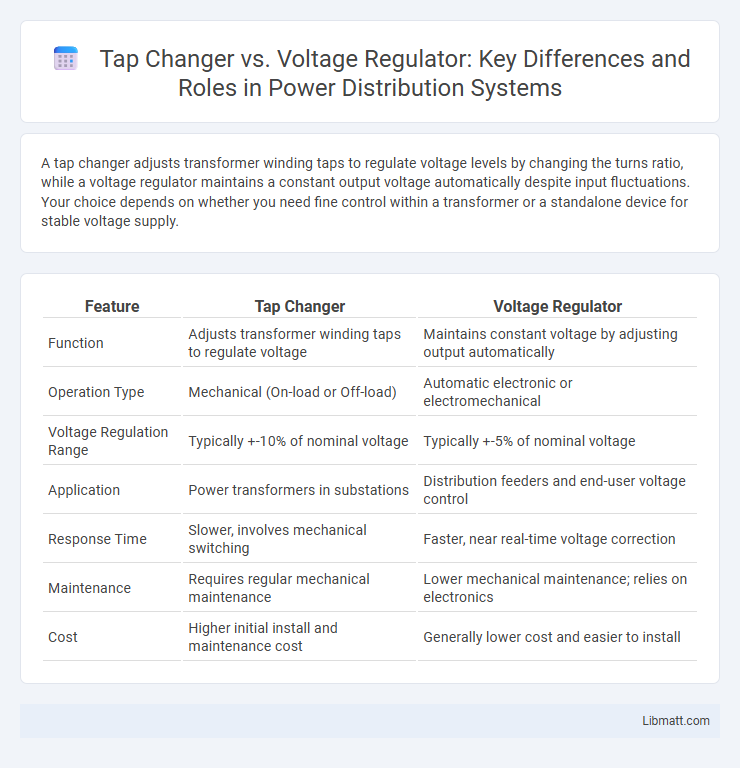A tap changer adjusts transformer winding taps to regulate voltage levels by changing the turns ratio, while a voltage regulator maintains a constant output voltage automatically despite input fluctuations. Your choice depends on whether you need fine control within a transformer or a standalone device for stable voltage supply.
Table of Comparison
| Feature | Tap Changer | Voltage Regulator |
|---|---|---|
| Function | Adjusts transformer winding taps to regulate voltage | Maintains constant voltage by adjusting output automatically |
| Operation Type | Mechanical (On-load or Off-load) | Automatic electronic or electromechanical |
| Voltage Regulation Range | Typically +-10% of nominal voltage | Typically +-5% of nominal voltage |
| Application | Power transformers in substations | Distribution feeders and end-user voltage control |
| Response Time | Slower, involves mechanical switching | Faster, near real-time voltage correction |
| Maintenance | Requires regular mechanical maintenance | Lower mechanical maintenance; relies on electronics |
| Cost | Higher initial install and maintenance cost | Generally lower cost and easier to install |
Introduction to Tap Changers and Voltage Regulators
Tap changers and voltage regulators are essential components in electrical power systems for maintaining stable voltage levels. Tap changers adjust transformer winding taps to regulate voltage by changing the turns ratio, while voltage regulators automatically control output voltage by varying electrical parameters within the circuit. Understanding the function and operation of tap changers versus voltage regulators helps optimize your power system's performance and reliability.
Basic Working Principles
Tap changers adjust transformer voltage by changing transformer winding connections to regulate output voltage under varying load conditions. Voltage regulators maintain a constant output voltage by electronically controlling voltage through power electronic devices or mechanical components in real-time. Both devices ensure stable voltage supply, but tap changers modify transformer taps while voltage regulators actively manage voltage levels continuously.
Key Differences Between Tap Changers and Voltage Regulators
Tap changers adjust transformer winding taps to regulate voltage levels in high-voltage power distribution systems, offering discrete voltage steps. Voltage regulators provide continuous voltage adjustment by controlling output voltage in real-time, essential for maintaining stable low-voltage supply. Tap changers are primarily used in transformers for coarse voltage control, whereas voltage regulators ensure fine, dynamic voltage stability on distribution feeders.
Core Components and Design
Tap changers use mechanical switch contacts to adjust transformer winding taps, enabling discrete voltage level changes, while voltage regulators rely on electronic components such as power semiconductor devices and control circuits for continuous voltage adjustment. Tap changers typically incorporate diverter switches, off-load or on-load mechanisms, and selector contacts designed for high current operations, ensuring reliable stepwise voltage control. Voltage regulators feature sensors, microprocessor controls, and solid-state devices to provide precise, rapid voltage stabilization with minimal mechanical wear.
Application Areas in Power Systems
Tap changers are primarily used in transformers within power transmission and distribution networks to adjust voltage levels and maintain system stability under varying load conditions. Voltage regulators, often installed in distribution feeders and consumer substations, provide continuous voltage control to ensure consistent power quality for end-users. Your choice between these devices depends on specific power system requirements such as voltage range, regulation speed, and application environment.
Advantages of Tap Changers
Tap changers offer precise voltage control by adjusting transformer winding taps without interrupting the load, ensuring continuous power supply. They enhance transformer efficiency and extend equipment lifespan through smooth voltage regulation, minimizing electrical stresses. Their capability to maintain stable voltage under varying load conditions reduces the risk of power quality issues and improves overall system reliability.
Benefits of Voltage Regulators
Voltage regulators provide precise and continuous control of output voltage, enhancing electrical equipment's performance and lifespan by maintaining stable voltage levels. They offer automatic correction of voltage fluctuations, reducing the risk of damage and minimizing downtime in industrial and residential applications. Your electrical systems benefit from improved energy efficiency and reduced maintenance costs with reliable voltage regulation.
Common Challenges and Limitations
Tap changers and voltage regulators both address voltage control but face common challenges such as contact erosion, mechanical wear, and response time delays affecting system stability. Tap changers often struggle with arcing and maintenance requirements, while voltage regulators may have limited voltage adjustment ranges and slower response under rapid load changes. Understanding these limitations helps you optimize selection and maintenance strategies for reliable voltage regulation in power systems.
Selection Criteria for Power Systems
Tap changers and voltage regulators play critical roles in power systems for maintaining voltage stability and quality. Selection criteria emphasize load variation, system voltage level, response time, and cost-effectiveness, where tap changers are preferred for high-voltage transformers with significant load fluctuations, and voltage regulators suit distribution networks with moderate voltage adjustments. Reliability, maintenance requirements, and integration with existing infrastructure are also key factors influencing the choice between these devices.
Future Trends in Voltage Control Technology
Future trends in voltage control technology emphasize the integration of smart tap changers and advanced voltage regulators with IoT and AI capabilities for real-time grid monitoring and adaptive voltage management. Enhanced sensor networks and machine learning algorithms enable predictive maintenance and dynamic adjustment, improving energy efficiency and grid stability. These innovations support the rise of decentralized renewable energy sources and the evolution toward smarter, more resilient power distribution systems.
Tap Changer vs Voltage Regulator Infographic

 libmatt.com
libmatt.com